6 FF mystery vinyl records : 5 DJ Grooves and Reworks + 1 surprise record
Bring yesterday’s magic to today’s dancefloors.
lp
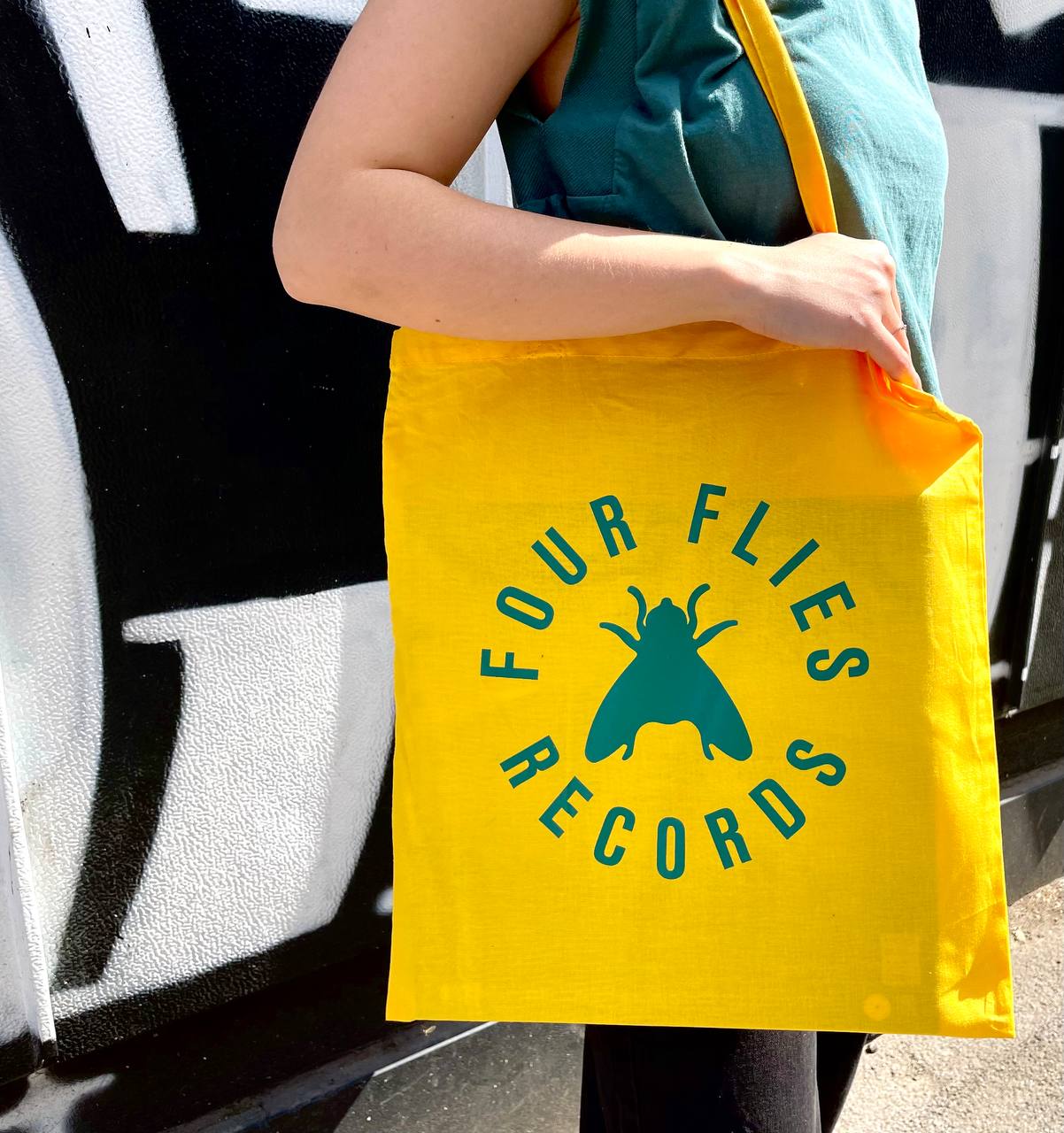
Bring yesterday’s magic to today’s dancefloors.

Explore the Italian library gems that we’ve rescued from oblivion.
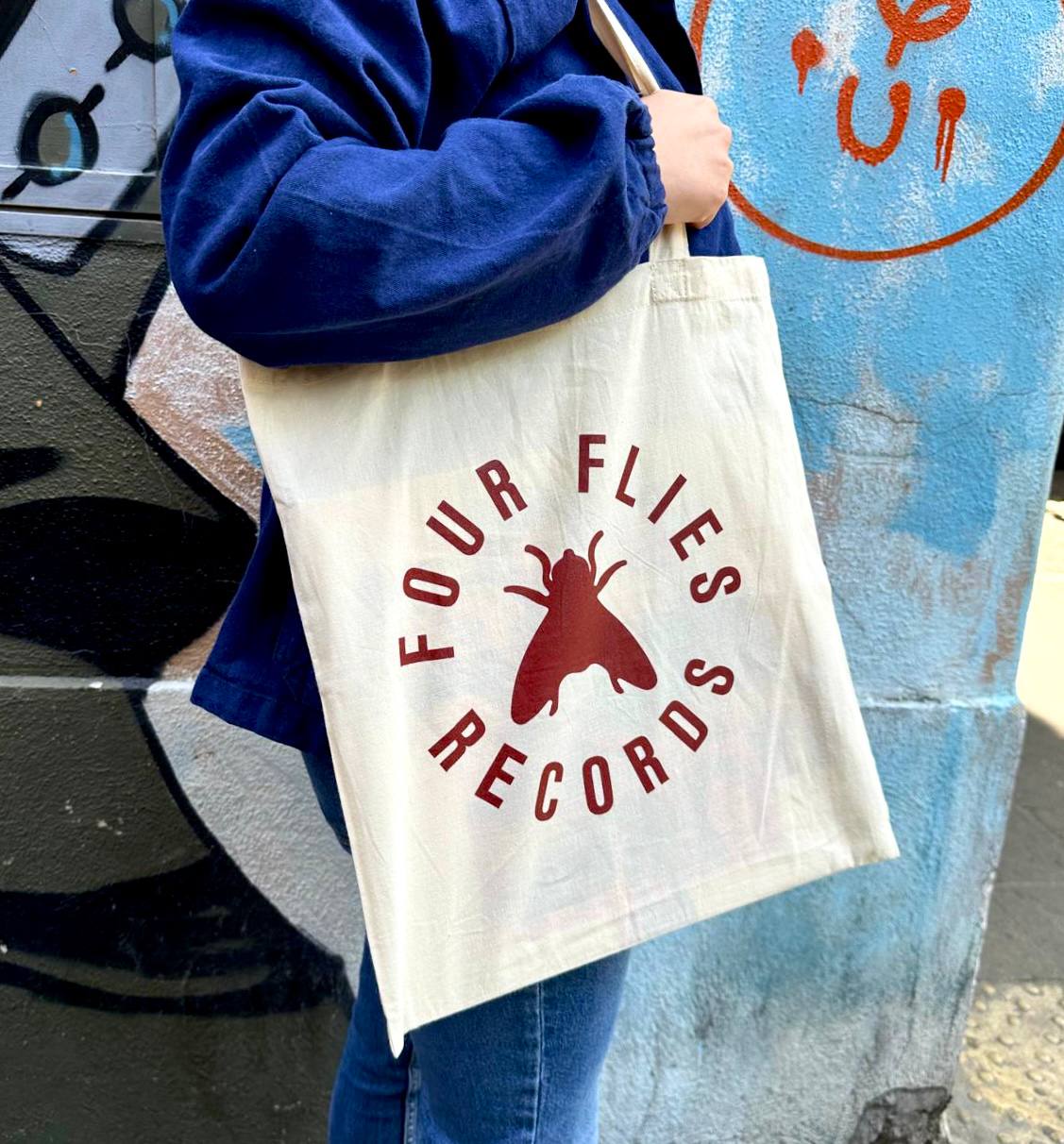
Immerse yourself in the elegance of Italian golden age soundtracks.

Limited Edition Black Vinyl LP
Out on June 21st, 2024
TRACKLIST:
A1 – Fate Had Planned It So (film version) [feat. Lydia MacDonald]
A2 – Orgasmo – M5 (jet-set) [feat. Giulia De Mutiis]
A3 – Orgasmo – Seq. 1 (easy-living)
A4 – Orgasmo – M18 (shake)
A5 – Orgasmo – Seq. 2 (jazz pour l’action)
A6 – Orgasmo – M27 (psychedelic trap) [feat. Alessandro Alessandroni & Giulia De Mutiis]
A7 – Orgasmo – M2 (bossa)
A8 – Orgasmo – Seq. 3 (main theme)
A9 – Orgasmo – M46 (hammond valzer) [feat. Lydia MacDonald]
B1 – Orgasmo – Seq. 4 (samba-jazz)
B2 – Orgasmo – Seq. 5 (rhythmical suspense)
B3 – Orgasmo – Seq. 6 (psychedelic suspense) [feat. Giulia De Mutiis]
B4 – Orgasmo – M5 bis (bossa)
B5 – Orgasmo – M19 (shake)
B6 – Orgasmo – Seq. 7 (pop-jazz)
B7 – Orgasmo – M22 (bossa)
Limited Edition Black Vinyl LP
Four Flies is thrilled to announce a reissue of Piero Umiliani’s soundtrack to the 1969 giallo thriller ”Orgasmo” (called “Paranoia” in English speaking countries), the first of three erotically charged films directed by Umberto Lenzi and starring cult siren (and Oscar nominee) Carroll Baker. Back in 2020, we unveiled the first-ever release of this iconic soundtrack, whose master tapes were thought lost for decades. After some serious detective work in the composer’s archives, our team managed to salvage and restore the original tapes, bringing Umiliani’s score back to life for all to enjoy. Due to popular demand, this reissue, unlike the 2020 release, bears the film’s original Italian title.
Recorded shortly after ”Sweden: Heaven and Hell” in late 1968, Orgasmo is undoubtedly one of Umiliani’s finest works. The score perfectly captures the stylish and sleazy vibe of Lenzi’s film, its acid-drenched visuals, and its themes of sick psychological mind games (courtesy of the devious characters played by Swedish enfant terrible Lou Castel and French beauty Colette Descombes). Umiliani was arguably in his golden period here, at the peak of his compositional powers – elements like the vocals performed by Alessandro Alessandroni and his wife Giulia, or the Hammond parts played by Antonello Vannucchi, seem to foreshadow the atmospheric depths of future works, such as the soundtrack for Mario Bava’s Five Dolls for an August Moon (1970). At the same time, however, the score exudes a surprisingly cheerful vibe, thanks to its Brazilian influences and lively bossa-nova and samba-jazz rhythms. To top it all off, the sublime Lydia MacDonald lends her voice to the haunting “Fate Had Planned It So,” which plays in the opening titles sequence and thus sets the stage for the film’s enigmatic journey.
The LP comes in a lavish 650-gram single tip-on jacket adorned with new artwork. Available starting June 21, 2024.
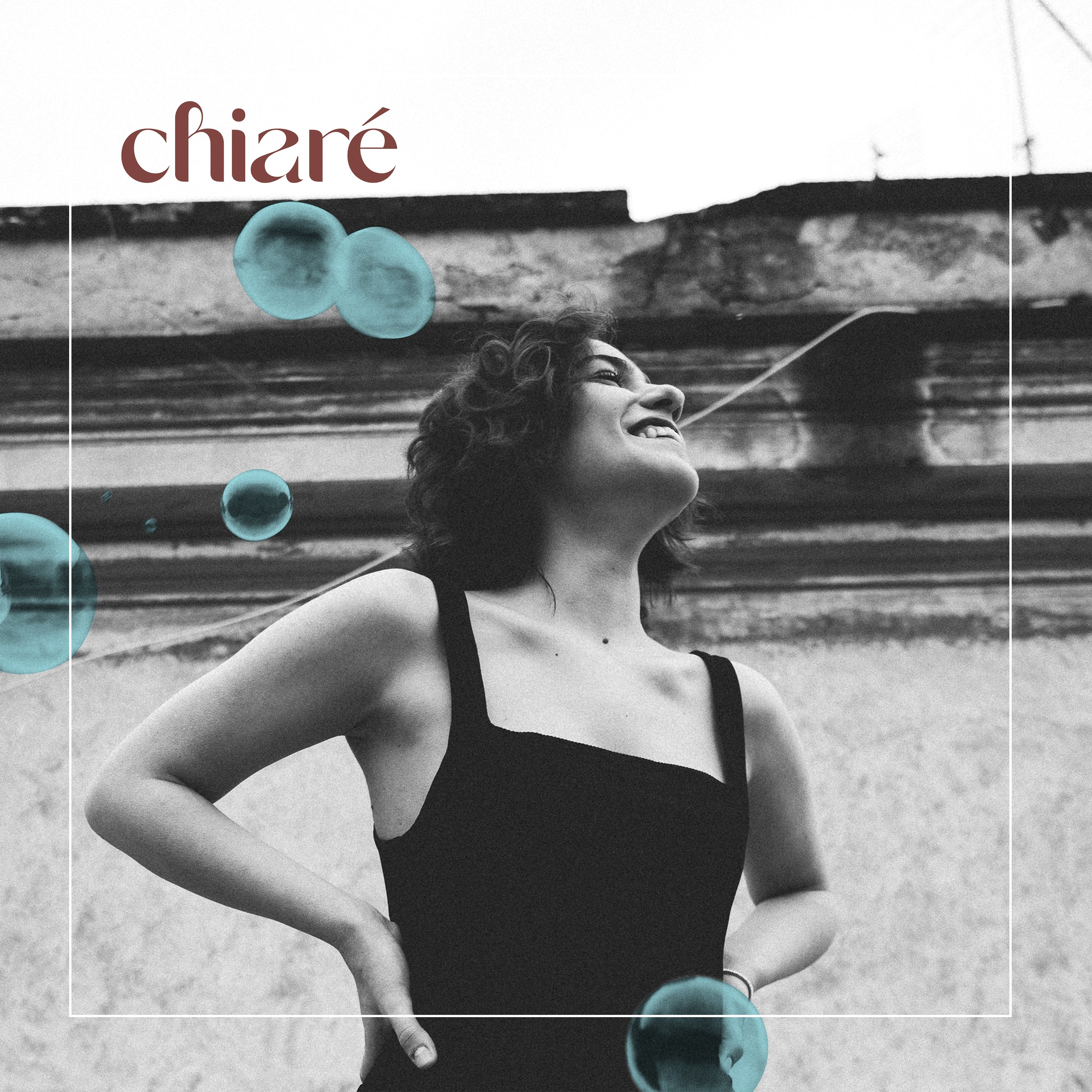
Black Vinyl LP
Out on April 16th, 2024
TRACKLIST:
A1 – Barocco
A2 – Zucchero a velo
A3 – Foria
A4 – Vulesse
B1 – Zanzare
B2 – Strategia
B3 – Nicotina
B4 – Scalinatella
Limited edition Black Vinyl LP
Following the singles “Zanzare” and “Barocco”, Chiaré is the self-titled debut album from songwriter and multi-instrumentalist Chiaré, aka Chiara Ianniciello, the latest recipient of the Bianca D’Aponte Award for emerging Italian singer-songwriters.
The album, which will be out on April 16th, contains eight atmospheric and intimate tracks where Chiara’s warm and gentle voice weaves snapshots from her feelings and her personal story over retro-flavoured, jazz-infused arrangements that are reminiscent of some of Italy’s finest singer-songwriters (Lucio Battisti and Pino Daniele in particular).
“It all started about three years ago,” says Chiara. “Ernesto Massimino Voza and I started from a sound that somehow wasn’t really me, and after a long process of trial and error, we finally found what seemed to be right for me. Peppe Maiellano, who arranged all the music, brought it full circle. The album has a common thread: love. Almost all of the songs are about strategic love, the fear of freely loving someone and the frustration at not being able to get out of an on-and-off relationship that made me suffer, but that I’ve tried to narrate with some irony. If my writing were an artistic movement, it would be naturalism. I drew a lot of inspiration from Pino Daniele, Eduardo De Crescenzo, and Lucio Battisti, while trying to develop my own personal, authentic style.”
Chiara holds a diploma in jazz singing and is now completing her studies in classical double bass. In her debut album she uses both standard Italian and the Neapolitan dialect, mixing jazz, soul and R’n’B. Modernity and tradition come together, creating a delicate yet irresistible sound.
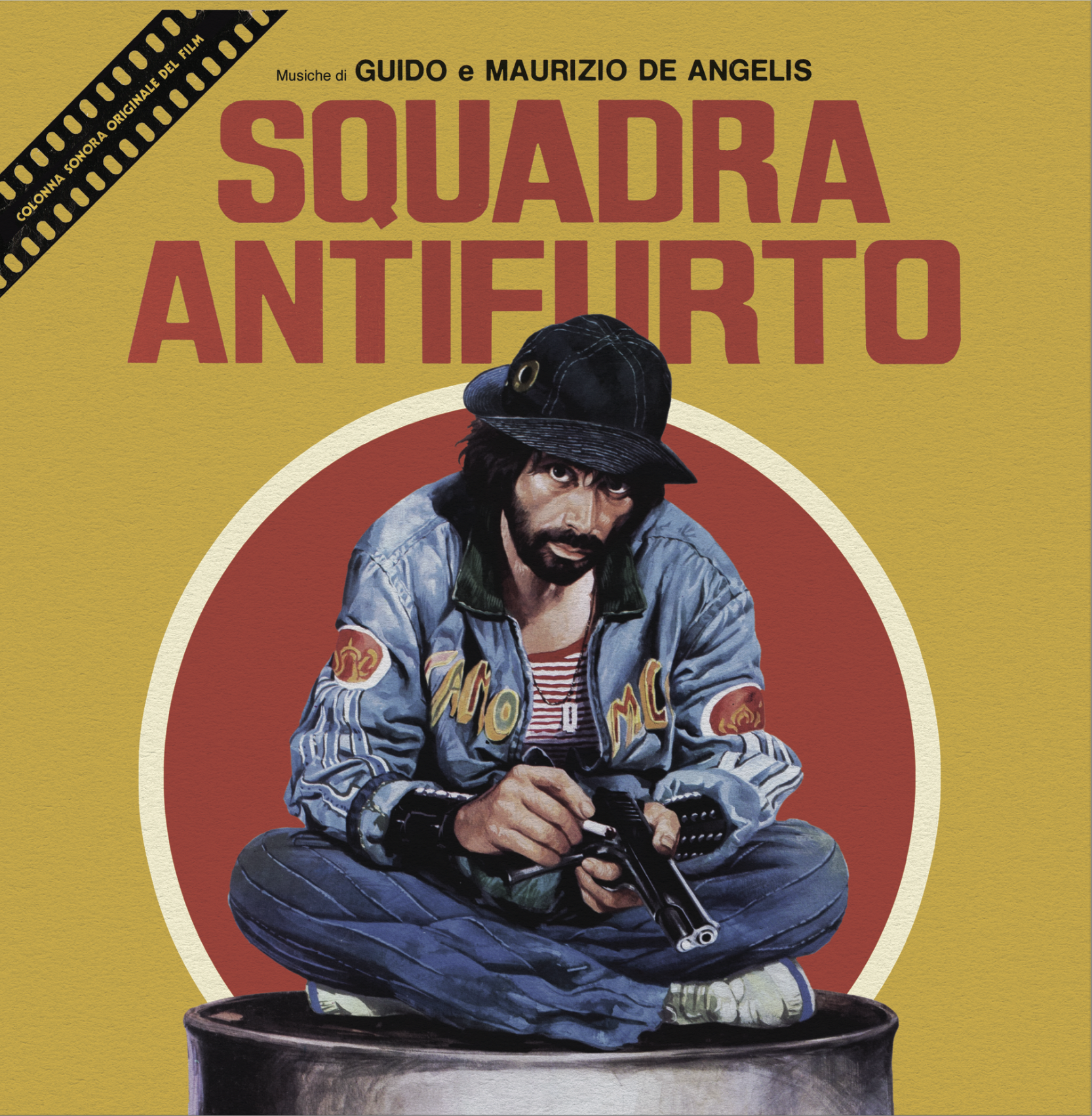
Limited Edition Transparent Amber Vinyl LP
Out on April 12th, 2024
TRACKLIST:
A1 – E nun ce voio sta
A2 – Squadra antifurto (Suspense)
A3 – Squadra antifurto (Azione e mistero)
A4 – Squadra antifurto (Azione)
A5 – Squadra antifurto (Nico a New York)
A6 – E nun ce voio sta (Versione fisarmonica e chitarra)
B1 – Squadra antifurto (Nico a New York #2)
B2 – Squadra antifurto (Azione #2)
B3 – Squadra antifurto (Suspense #2)
B4 – Squadra antifurto (Azione #3)
B5 – E nun ce voio sta (Versione chitarra)
B6 – Squadra antifurto (Azione e mistero #2)
B7 – Squadra antifurto (Azione e mistero #3)
B8 – E nun ce voio sta (Titoli di coda)
Limited edition Transparent Amber Vinyl LP (300 copies WW)
Here at Four Flies, we kind of feel we need a bigger word than ‘proud’, this time, to present, in collaboration with Beat Records, the first-ever release of the original soundtrack written in 1976 by Guido & Maurizio De Angelis for the legendary Squadra Antifurto, the second chapter of the comedy-infused crime saga directed by Bruno Corbucci and starring Tomas Milian as the iconic Italian Police Marshal Nico Giraldi.
The excitement in this case is nothing short of gigantic, difficult to rein in for those who, like ourselves, grew up adoring the character played by Milian as one of our cult heroes, and dreaming that the soundtracks of the first three films in the saga – the only ones composed by the De Angelis brothers – would one day be released.
Since the launch of our label, Squadra Antifurto has been at the top of the list of film scores we most wanted to release. Until a few months ago, this dream of ours seemed destined to remain just that, so strong was the conviction in all of us that the master tapes were definitively lost, that they had forever vanished into thin air. That’s why their recovery, made possible by Maurizio De Angelis himself and the persistence of our friends at Beat Records, is an extraordinary feat.
Nearly 50 years after it was first heard in cinemas, the soundtrack penned by the De Angelis brothers is resurrected in its entirety and can finally shine its incredible power all over us.
Beautifully seeping through this score – like many others composed by the golden duo in the 1970s – are elements from the Italian, and especially Roman, folk tradition, for instance in the warm, heartfelt ballad sung by Alberto Griso, “E nun ce vojo sta,” which first plays in the opening credit sequence and is then reprised in various forms throughout the film, culminating with the soul-stirring orchestral version that closes the album’s tracklist.
But as in any Italian crime film worthy of that name, a different soundscape takes centre stage: it’s the music that accompanies the countless scenes of tension, action, and pursuit that punctuate the film, and which has made us fall madly in love with this score.
The main theme is a prog-funk joyride, drawing inspiration from the traditional tarantella but elevated to irresistible energy thanks to a rock orchestration featuring psychedelic flutes, wild percussion, distorted electric guitars, piano chords, and various feedback and delay effects.
The resulting groove is just mind-blowing, and we almost can’t believe it’s finally available on a record, completely remastered for vinyl.
We really couldn’t be prouder, and dedicate this release to all passionate fans of Italian crime films, the De Angelis brothers, and Tomas Milian aka Nico Giraldi.
Available starting April 12th on standard black vinyl and limited coloured vinyl (transparent amber, limited to 300 copies).

Black Vinyl LP
Out on April 12th, 2024
TRACKLIST:
A1 – E nun ce voio sta
A2 – Squadra antifurto (Suspense)
A3 – Squadra antifurto (Azione e mistero)
A4 – Squadra antifurto (Azione)
A5 – Squadra antifurto (Nico a New York)
A6 – E nun ce voio sta (Versione fisarmonica e chitarra)
B1 – Squadra antifurto (Nico a New York #2)
B2 – Squadra antifurto (Azione #2)
B3 – Squadra antifurto (Suspense #2)
B4 – Squadra antifurto (Azione #3)
B5 – E nun ce voio sta (Versione chitarra)
B6 – Squadra antifurto (Azione e mistero #2)
B7 – Squadra antifurto (Azione e mistero #3)
B8 – E nun ce voio sta (Titoli di coda)
Limited edition Black Vinyl LP
Here at Four Flies, we kind of feel we need a bigger word than ‘proud’, this time, to present, in collaboration with Beat Records, the first-ever release of the original soundtrack written in 1976 by Guido & Maurizio De Angelis for the legendary Squadra Antifurto, the second chapter of the comedy-infused crime saga directed by Bruno Corbucci and starring Tomas Milian as the iconic Italian Police Marshal Nico Giraldi.
The excitement in this case is nothing short of gigantic, difficult to rein in for those who, like ourselves, grew up adoring the character played by Milian as one of our cult heroes, and dreaming that the soundtracks of the first three films in the saga – the only ones composed by the De Angelis brothers – would one day be released.
Since the launch of our label, Squadra Antifurto has been at the top of the list of film scores we most wanted to release. Until a few months ago, this dream of ours seemed destined to remain just that, so strong was the conviction in all of us that the master tapes were definitively lost, that they had forever vanished into thin air. That’s why their recovery, made possible by Maurizio De Angelis himself and the persistence of our friends at Beat Records, is an extraordinary feat.
Nearly 50 years after it was first heard in cinemas, the soundtrack penned by the De Angelis brothers is resurrected in its entirety and can finally shine its incredible power all over us.
Beautifully seeping through this score – like many others composed by the golden duo in the 1970s – are elements from the Italian, and especially Roman, folk tradition, for instance in the warm, heartfelt ballad sung by Alberto Griso, “E nun ce vojo sta,” which first plays in the opening credit sequence and is then reprised in various forms throughout the film, culminating with the soul-stirring orchestral version that closes the album’s tracklist.
But as in any Italian crime film worthy of that name, a different soundscape takes centre stage: it’s the music that accompanies the countless scenes of tension, action, and pursuit that punctuate the film, and which has made us fall madly in love with this score.
The main theme is a prog-funk joyride, drawing inspiration from the traditional tarantella but elevated to irresistible energy thanks to a rock orchestration featuring psychedelic flutes, wild percussion, distorted electric guitars, piano chords, and various feedback and delay effects.
The resulting groove is just mind-blowing, and we almost can’t believe it’s finally available on a record, completely remastered for vinyl.
We really couldn’t be prouder, and dedicate this release to all passionate fans of Italian crime films, the De Angelis brothers, and Tomas Milian aka Nico Giraldi.
Available starting April 12th on standard black vinyl and limited coloured vinyl (transparent amber, limited to 300 copies).
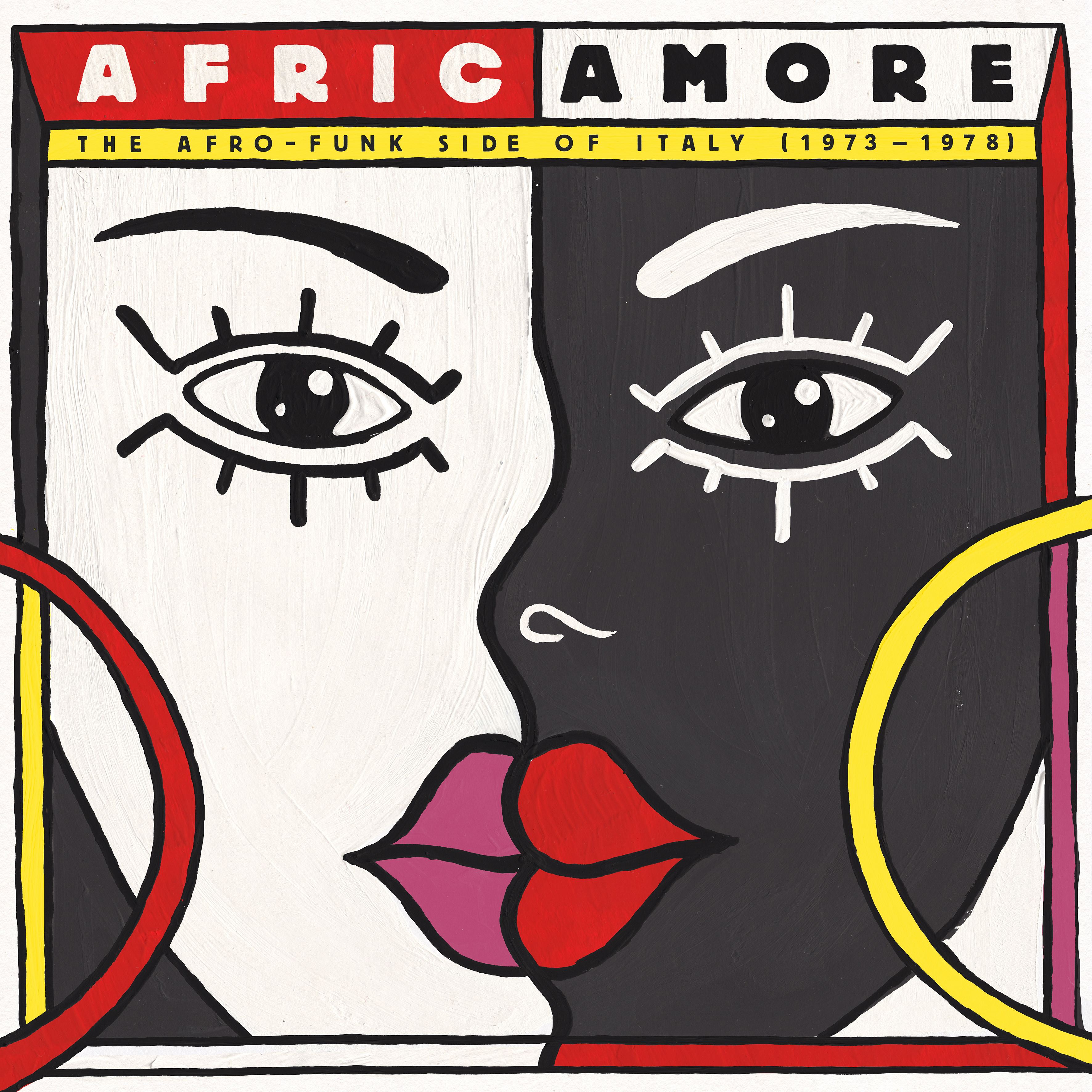
Continuing Four Flies’ dedication to delving into lesser-explored periods of Italian music, Africamore takes us on a captivating journey into the intersection of Afro-funk and the Italian soundscape during the six years between 1973 and 1978 – a time when disco was looming on the horizon and the nightclub market was rapidly expanding.
Before reaching Italian shores, the infectious sound originating from African and Afro-Caribbean roots traversed both the Mediterranean and the Atlantic, landing on New York dancefloors, where DJ Dave Mancuso discovered “Soul Makossa” by Manu Dibango. In 1973, from Mancuso’s Loft parties, the song’s hypnotic groove spread to the rest of the globe, including in Italy, where it sparked a wave of imitations and variations.
Tribal influences thus found their way into Italian soul-funk and early-disco productions released between 1973 and 1978 – from psychedelic-tinged tunes like Jean Paul & Angelique’s “Africa Sound” to the Afrobeat-inspired club banger “Kumbayero” by composer/producer Albert Verrecchia (aka Weyman Corporation); and from groundbreaking Afro-cosmic songs like Chrisma’s “Amore”, co-written by Vangelis and featuring the rhythms of Ghanaian-British Afro-rock band Osibisa, to mind-blowing floor-fillers like Beryl Cunningham’s “Why O”, a re-write of Nat King Cole’s “Calypso Blues” arranged by Paolo Ormi, with percussion breaks that sound pretty much like what would later become known as techno.
Combining feel-good vibes with driving rhythms, world-style percussion, and even synths, all these productions pushed the boundaries of dance music at a time when disco had not yet taken over. In doing so, they sowed many of the seeds of the later Italian cosmic scene and its unique mixture of African elements, disco-funk and electronic music.
This was a brief but nuanced period in Italian music history, one that deserves to be rediscovered, with love.
Africamore is due out on March 22nd and will be available as a gatefold 2LP and digipak CD. Both formats come with stunning artwork by Kathrin Remest and liner notes by Pierpaolo De Sanctis and Elena Miraglia.
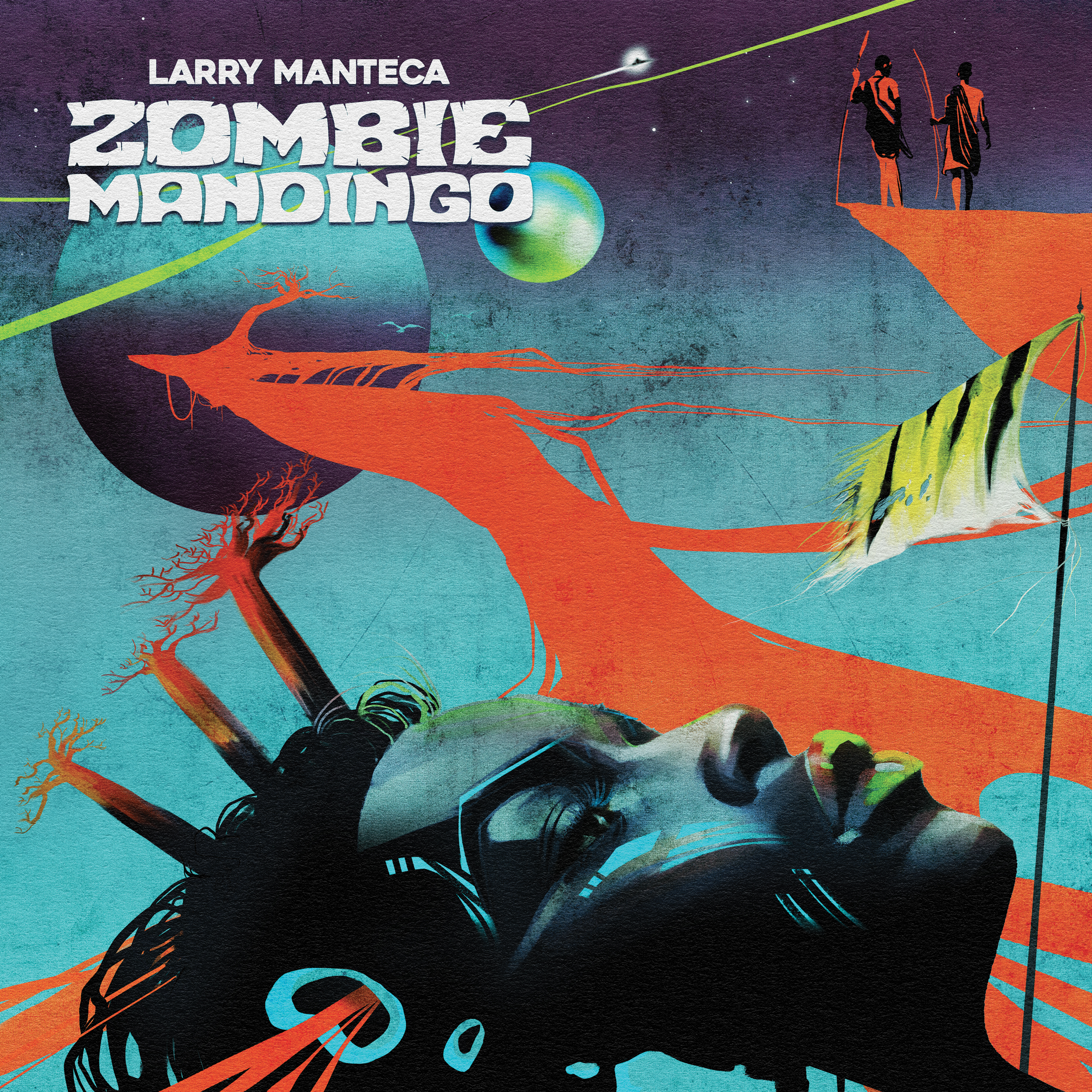
LP Vinyl Black
Out on February 9th, 2024
TRACKLIST:
A1 – Zombie Mandingo
A2 – Tuareg Road
A3 – Blue Eyes
A4 – Ritual
B1 – Around The Island
B2 – Love And Bones
B3 – Voodoo Hunter
B4 – Hanuman
B5 – Zombie Mandingo (Trailer Music)
Limited edition LP Vinyl Black w/ tip-on jacket
After over a decade as a digital-only album, Larry Manteca’s Zombie Mandingo gets its first vinyl release, making a fresh comeback in a completely renewed version.
Like Manteca’s previous full-length releases, this album too is conceived as a soundtrack to a non-existent exploitation film, drawing inspiration from the classic Italian B-movies of the 1970s. This time, cinematic references encompass both the zombies found in Lucio Fulci’s horrors and the cannibalistic adventures directed by Umberto Lenzi, creating a strange mash-up between Jacopetti’s Mondo Cane and Deodato’s Cannibal Holocaust.
The setting is an unspecified island in the Atlantic Ocean, nestled halfway between equatorial Africa and the Caribbean. A handful of Western tourists, having miraculously survived a plane crash, collide with the age-old rituals of an indigenous tribe who perform human sacrifices to appease their local god—the Zombie Mandingo of the title—a monstrous creature with superhuman strength, half Haitian zombie, half African cannibal.
This fusion of genres and cultures is reflected in the music. Manteca creates horror-tinged exotica that evokes and re-imagines the soundscapes of distant lands and dreamlands, from Africa to South America, to the mysterious islands in the Bermuda Triangle. He boldly and brilliantly combines Les Baxter with Fela Kuti, Joe Zawinul with Piero Umiliani, Janko Nilovic with KPM libraries, sprinkling the mixture profusely with psychedelia, Afro-groove, and Italian soundtrack vibes.
The album’s nine tracks, recorded between 2013-2019, were meticulously remixed and remastered in 2023. This process made it possible to add new solo instruments, including the Fender Rhodes on the title track. The result is a captivating, kaleidoscopic journey taking us into the sonic depths of the tropical jungle to unveil its dark secrets and surrender to the primary emotions behind every B-movie: action, adventure, erotic desire, and fear.
The album is embellished with a 650-gram hardcover sleeve featuring breathtaking artwork by Matteo Fumagalli.
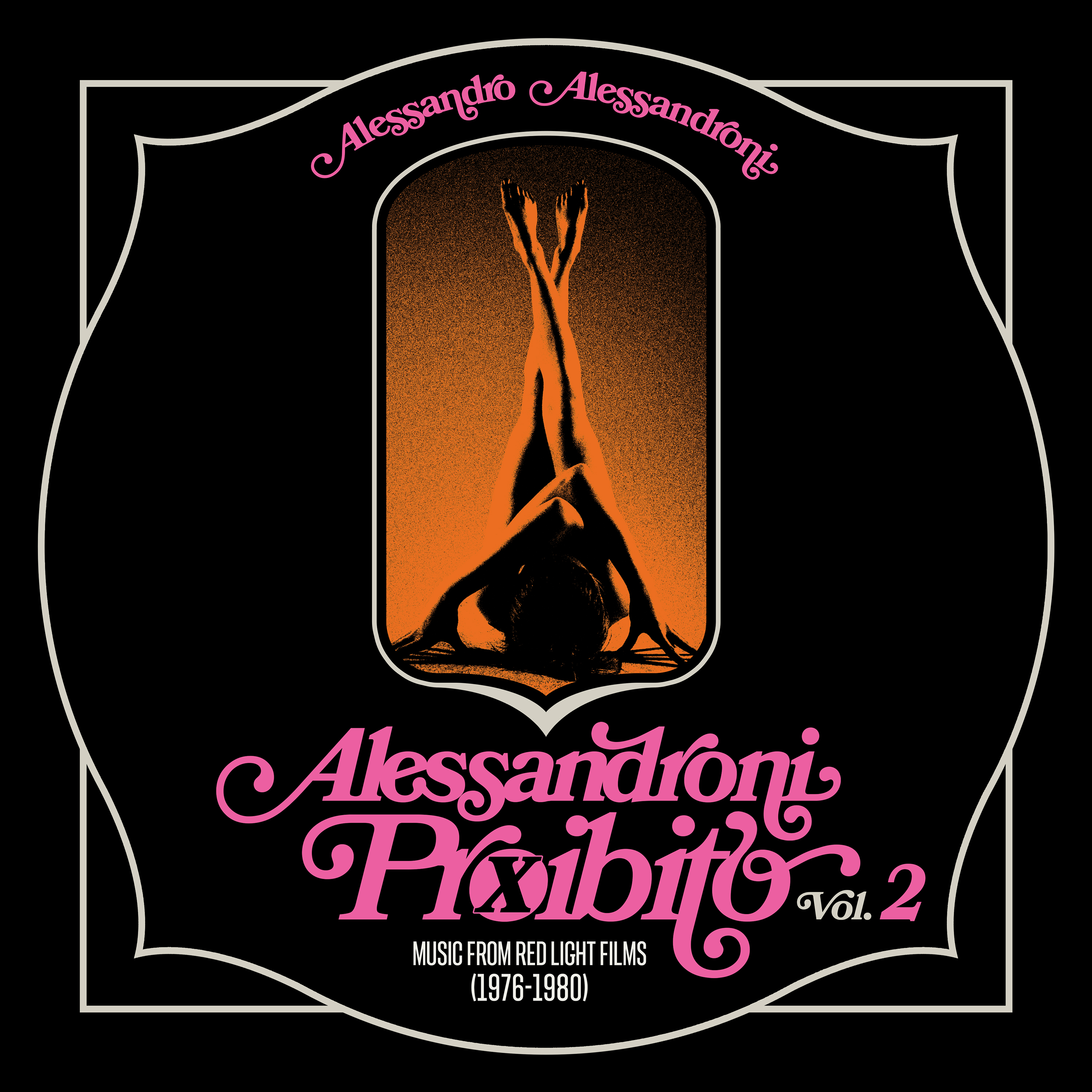
Boxed Set of five 7-inch vinyl records, 400 copies limited edition. Artwork poster included.
Out on December 1st, 2023
FLIES 45-55 | AP6
Lato A
dal film L’ADOLESCENTE
A1 – LUCI ROSA
Lato B
dal film L’ADOLESCENTE
B1 – RAGAZZA DI CAMPAGNA
FLIES 45-56 | AP7
Lato A
dal film EMANUELLE A TAHITI
A1 – SNAKE DISCO (REPRISE)
Lato B
dal film EMANUELLE A TAHITI
B1 – TAHITI JOINT
FLIES 45-57 | AP8
Lato A
dal film UOMO UOMO UOMO
A1 – MISS X
Lato B
dal film UOMO UOMO UOMO
B1 – MODELING
FLIES 45-58 | AP9
Lato A
dal film FRITTATA ALL’ITALIANA
A1 – TICKET (VERSIONE SEXY)
Lato B
dal film FRITTATA ALL’ITALIANA
B1 – PRIMI APPROCCI
FLIES 45-59 | AP10
Lato A
dal film LE PORNOSCHIAVE DEL VIZIO
A1 – CLIMAX
Lato B
dal film LE PORNOSCHIAVE DEL VIZIO
B1 – RACING
5 x 7-inch box set with 30x70cm poster. Limited edition of 400.
After the success of the first Alessandroni Proibito box set, which sold out in pre-sale before it even hit the stores, Four Flies is proudly back with Volume 2 of the compilation. This new release too features five exclusive 7-inches, housing a total of 10 seriously rare tunes. All previously unreleased in physical format, the tracks have been carefully selected from the soundtracks of five obscure Italian films from the late ‘70s – sexy flicks that flirted with the line between erotic and explicit, and which are now largely forgotten, having been out of circulation for decades.
As was the case with the previous volume of the compilation, Alessandroni’s music rises above the films’ flimsy plots, improvised actors, and amateurish production, exuding his distinctive touch thanks to the (typically Italian) artisanal approach he took to his musical craft. The composer let his creativity run free, playing with his instruments at home as if he were in his own little amusement park; trying to have fun and produce something entertaining and captivating with just the few means at his disposal.
This creative freedom turned even budget limitations into musical strength. Armed with just a 4-track Teac, Alessandroni recorded the rhythmic elements first and then added layers of melodic variations on top, at times relying on wordless vocals provided by skilled family members (Alessandroni himself in “Racing”, or his wife Giulia De Mutiis in “Ticket”), and at others on affordable or readily available instruments from the Italian folk tradition, such as the mandolin, the accordion, the melodica, or the diatonic harmonica. And of course, let’s not forget his unmistakable guitar! Whether classical or electric, it’s the heartbeat of every track in this compilation, from the seductive suspense of “Luci Rosa” (i.e., ‘pink lights’) to the groovy disco-funk of “Snake Disco (Reprise)”, all the way to the brilliant proto-wave of “Climax.” To top it off, a splash of DIY electronica – think minimalist drum machines and quirky synths – injects a modern feel into what we now call Italian erotic sound.
This time as well, the box set comes with artwork by Eric Adrien Lee, along with a matching 30x70cm folded poster inspired by the insert-size posters that used to deck out movie theaters.
Alessandroni Proibito Vol 2 (Music from Red Light Films 1976-1980) is being released in a limited edition of just 400 copies and will never be reissued. So, be quick – it’s first come, first served!
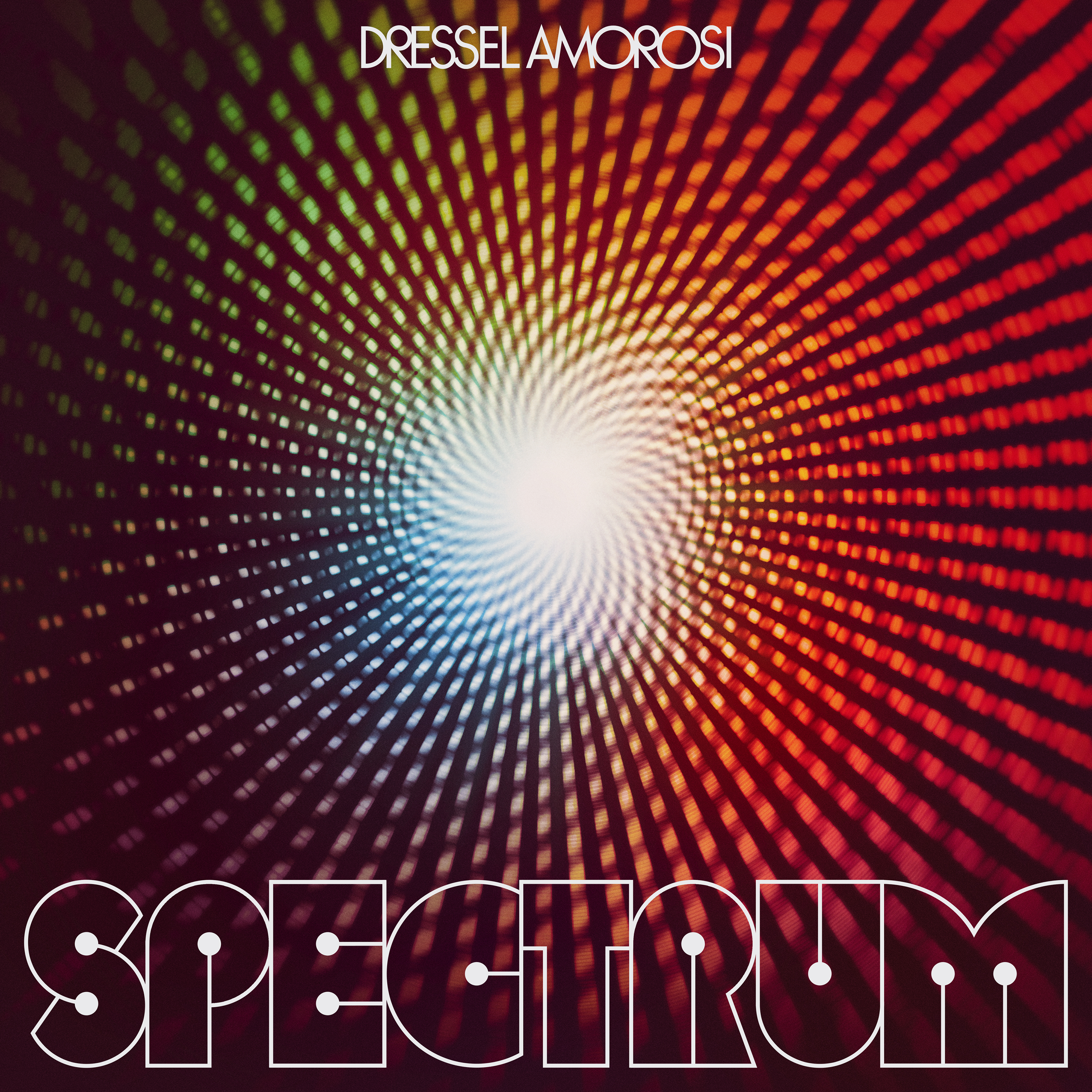
LP Vinyl Black
Out on November 17th, 2023
TRACKLIST:
A1 – Skipass
A2 – Voxson
A3 – Studio 70
B1 – Killing
B2 – Synthporn
B3 – Blitz
B4 – Redemption
Limited edition LP Vinyl Black w/ tip-on jacket
The new album from Italian duo Dressel Amorosi, comprising Federico Amorosi and Valerio Lombardozzi, is a fervent homage to the realm of Italian soundtracks and library music from the late ’70s and early ’80s. Navigating effortlessly through a spectrum of scenarios and atmospheres, it conjures up vivid images of action-packed sequences, wistful retro vibes, chic party scenes, and hair-raising horror chills.
With a refined, contemporary flair, Spectrum celebrates early ’80s cinema and its unmistakable aesthetics, steering clear of any trace of nostalgia. It weaves together elements of synth-pop, jazz-prog, electric fusion, and chill-funk across its seven compelling tracks, reimagining the past through a contemporary lens.
Compared to their previous, strictly horror-themed album, here Dressel Amorosi broaden their musical and cinematic palette, adding ingredients from the giallo, sexy thriller, comedy, and crime genres.
Their sonic exploration, too, strikes a delicate balance between the past and present. Federico Amorosi’s basslines resonate with the distinctive timbre of a Rickenbacker 4003, its effects ranging from time-honored classics like the Mutron pedal to more modern marvels like the Darkglass, with a sprinkle of ‘secret sauce’ to ensure a signature sound. In addition, Valerio Lombardozzi’s ‘arsenal of machines’ boasts iconic synthesizers such as the Roland Juno 106, the Korg MS 20, and the Farfisa Syntorchestra, which was a game-changer for an entire generation of Krautrock bands, including the early Tangerine Dream.
Merging an array of moods and hues into a mesmerizing chromatic tapestry, Spectrum summons the essence of late ’70s and early ’80s Italian cinema, reminding us of the astonishing diversity, enduring iconography, and sonic identity that defined that era. The album’s packaging, artwork and graphic layout intentionally channel the spirit of a classic library music LP from that period, or rather its deluxe version. The 650g hardcover sleeve, designed by specialist Eric Adrien Lee, is complemented on the back by descriptions of the atmospheres of each track, which back in the day were meant to guide music consultants and TV programmers in their selections.
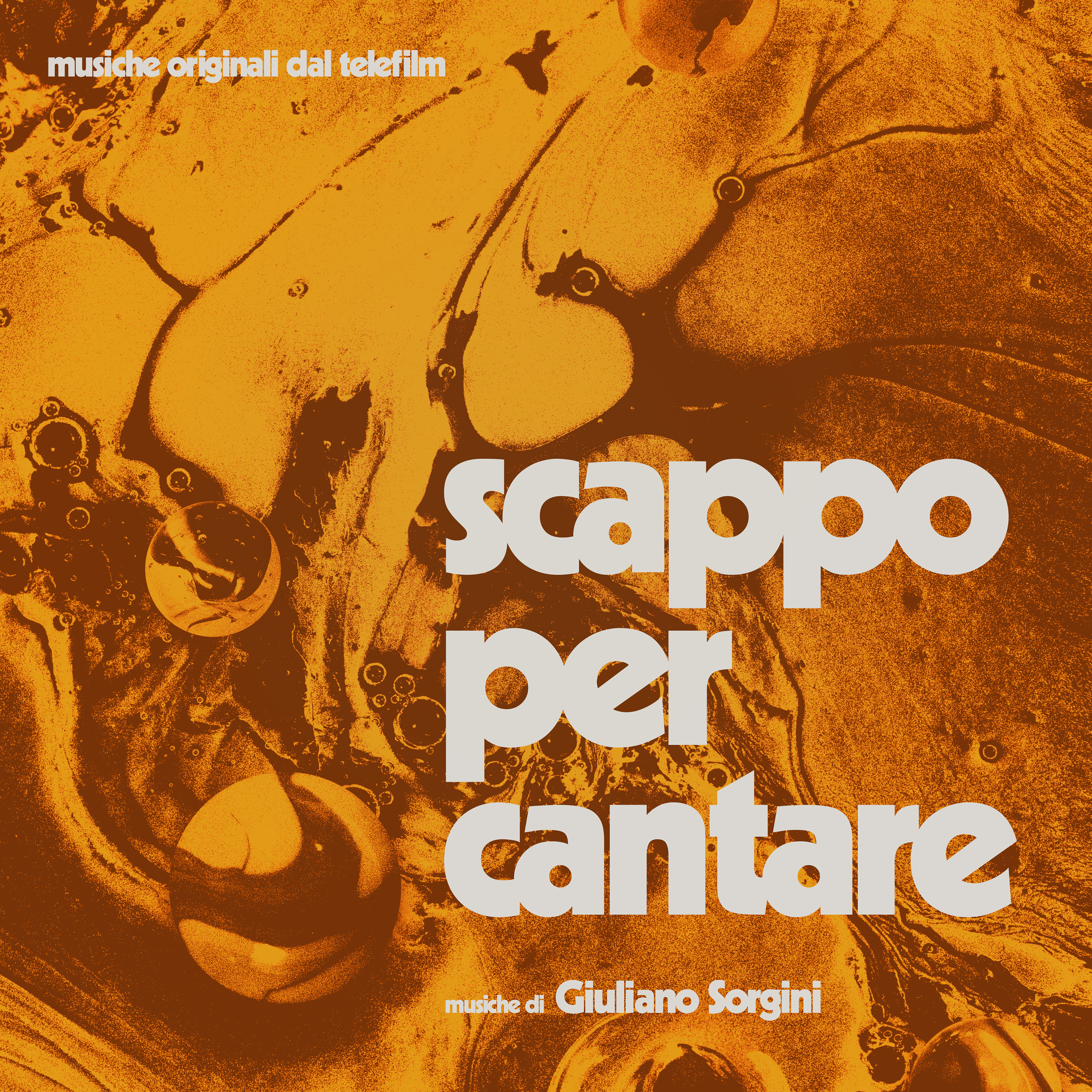
LP Vinyl Black
Out on October 6th, 2023
TRACKLIST:
A1 – Scogliere
A2 – Concentrazione
A3 – Calle Veneziana
A4 – Desolazione
A5 – Mordente
A6 – Fantocci Vivi
B1 – Con Amore
B2 – Scappo
B3 – Genocidio
B4 – Fendente
B5 – Per Cantare
B6 – Scogliere (2a Versione)
Limited edition LP Vinyl Black w/ tip-on jacket
Another dream coming true! One of Giuliano Sorgini’s finest and most sought-after titles is finally available as an official LP reissue – the first ever – remastered from the original tapes.
Originally released in 1971 on the small library music imprint FAMA, which operated as a sub-label of RCA Italy, the record contains the original music written for Scappo per cantare, a small, pseudo-psychedelic ‘musicarello’ (musical comedy film) broadcast on RAI television and starring, among others, Italian singers Gianni Morandi and Mauro Lusini.
The only credited album artist is Sorgini, but it’s impossible not to perceive, in this record, the hand of his close friend and colleague Alessandro Alessandroni.
This should not come as a surprise. In the early 70s, the two composers and multi-instrumentalists had a fruitful collaboration that saw them, under the monikers Braen (Alessandroni) and Raskovich (Sorgini), produce an abundance of works together, most of which have now gained the recognition they deserve. These include, among others, two 7” singles from their band The Pawnshop, three records in the series Alle sorgenti delle civiltà (Folkmusic), the crime/noir library albums Quarta pagina (Usignolo) and Inchiesta giudiziaria (Octopus Records), as well as the LP Tempo Libero (Panda Records), which was released shortly after the record presented here and in some ways drew rhythmic inspiration from it.
While their collaboration remained unacknowledged on the original release of Scappo per cantare (this was not uncommon at the time, especially in the field of library music), the record sounds perfectly in line with other works composed by Alessandroni in the early 70s, such as Complesso Gisteri’s Mostra Collettiva (co-written with Oronzo De Filippi), or even a landmark album like Spontaneous, where Sorgini contributed to a handful of tracks.
So, yes, the sheer beauty of Scappo per cantare is the result of an incredible synergy between two heavyweights of Italian library music! Airy and sweeping melodies à la Zoo Folle, psychedelia à la Under Pompelmo, and various percussion instruments played by Sorgini seamlessly blend and fuse with elements and touches provided by Alessandroni.
More specifically, we find Alessandroni’s signature, melancholy whistle in “Desolazione”; the peaceful and dreamy sound of his 12-string guitar in “Scogliere” and “Con Amore”; the trademark harmonies of his vocal ensemble Cantori Moderni in the last two tracks mentioned and in “Per cantare”; and his ingenious use of distortion on his Fender Stratocaster in the suspenseful transitions “Concentrazione” and “Fantocci”, as well as in the frantic/hypnotic hippie numbers “Mordente” and “Fendente” (as a side note, it is worth remembering that Alessandroni experimented extensively with distortion in the rock-infused album Underground, co-written with De Filippi and released in 1971 under the moniker Braen’s Machine, probably a reference to British psychedelic band Soft Machine).
The creative relationship between Sorgini and Alessandroni was so symbiotic that it would be useless to try to identify in more detail their respective contributions to the sound of Scappo per cantare. The alchemy between these two musical geniuses is the key to the album’s exquisitely Italian mixture of cheerful lounge, sweet psychedelia and smooth easy listening.
To do justice to the quality of the music, this remastered reissue is enriched by a new artwork by Eric Adrian Lee, who drew inspiration from the psychedelic visual culture of the period in which the album was written and recorded.
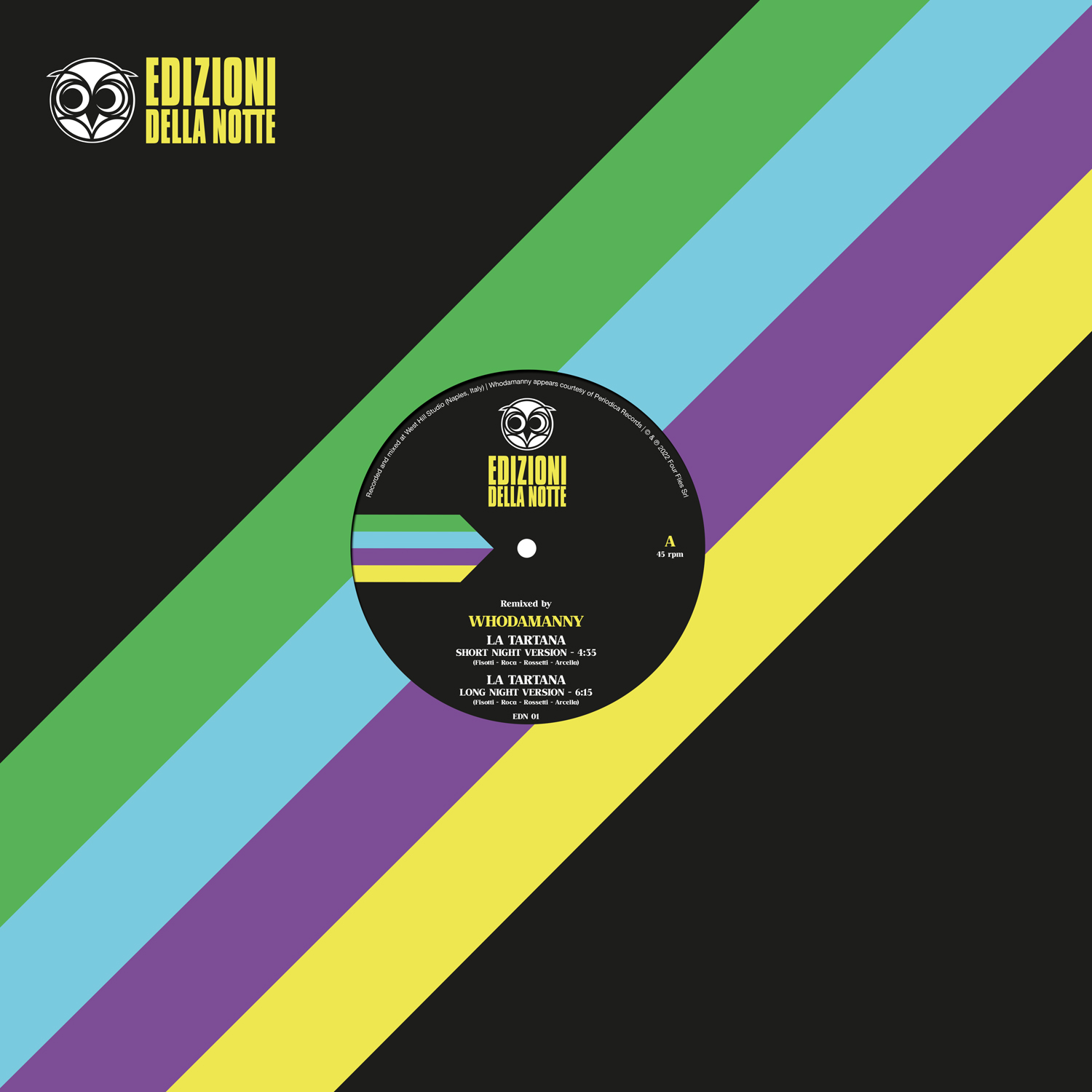
12″ Vinyl Black
Out on May 5th, 2023
TRACKLIST:
A1) Whodamanny – La Tartana (Short Night Version)
A2) Whodamanny – La Tartana (Long Night Version)
B1) Francesco Fisotti – La Tartana
Four Flies’ new imprint Edizioni della Notte is back with a 12-inch maxi single of infectious remixes of Francesco Fisotti’s boogie funk track “La Tartana” by eclectic Neapolitan DJ/producer Whodamanny.
The original track, which comes from the 2021 album Lido Sirena (named after a beach resort in the Salento area of Apulia, where Fisotti used to spend his summers as a child), blends funky disco, synths, drum-machine beats and improvisation into an exciting new sound that Fisotti calls “Adriatic funk”.
Inspired by slow-tempo but irresistible Italo and cosmic disco tunes, in particular Tonino Balsamo’s 1983 “Sta Guagliona Mo Ddà” (one of the rarest Neapolitan grooves ever, recently reissued by Periodica Records), Whodamanny’s two remixes amplify the original’s dancefloor potential by adding a nocturnal vibe and elements such as synths and electronic drums, as well as a short vocal line (“Don’t stop till the music stops”) to create a catchy call-and-response effect.
Whodamanny himself explains that he produced not one, but two remixes due to his love of extended dub versions. “It’s sort of a professional quirk,” – he says – “but you know, it’s inevitable. You’re sitting at the mixer, listening over and over to a track… Of course you’ll find bits you can stretch out to create a fantastic flow! And my approach is always the approach of a DJ. I want whatever I produce to work well in my DJ sets, so these remixes too were bound to be club-oriented.”
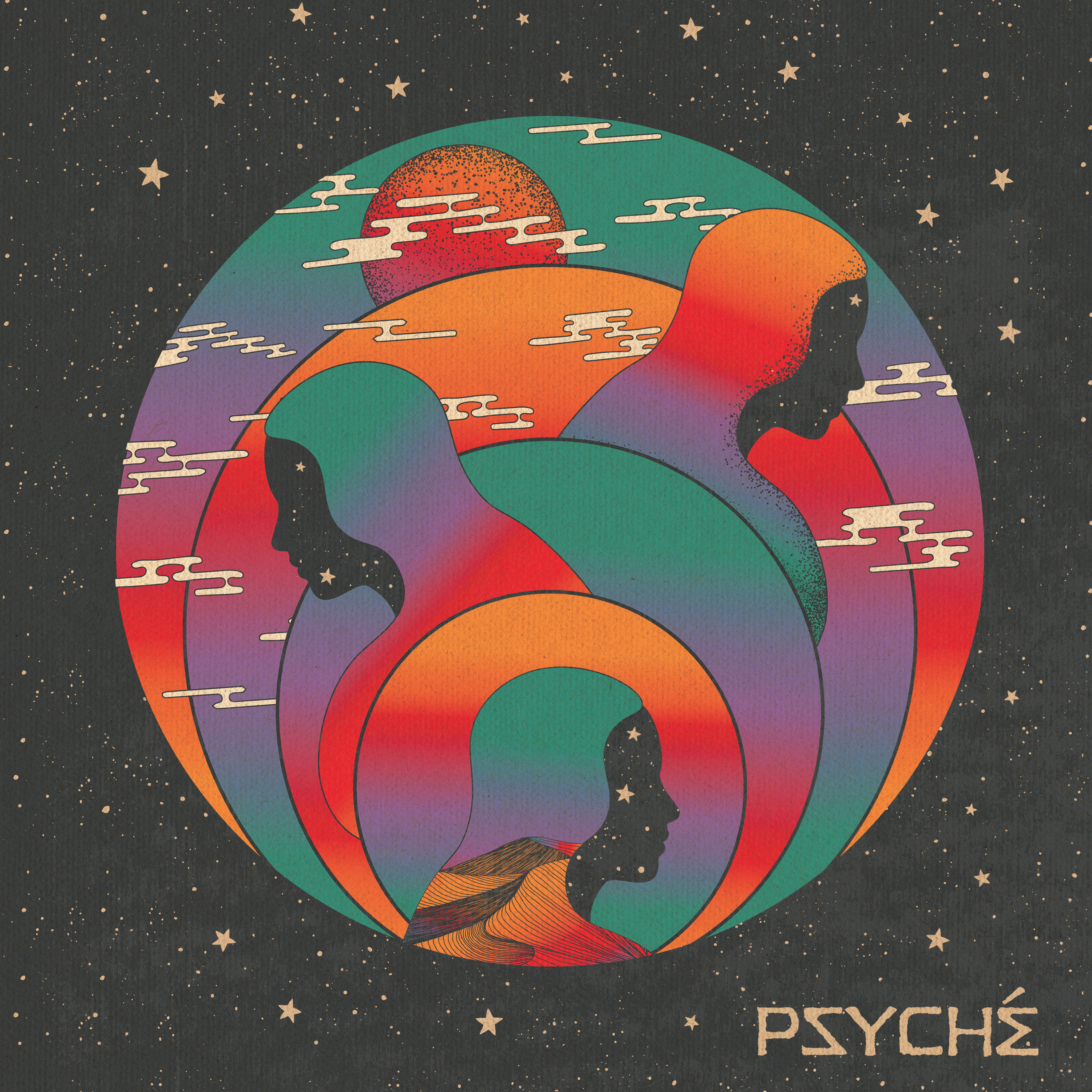
CD Digipak
Out on May 19th, 2023
TRACKLIST:
1 – Kuma
2 – Cumbia Mahàre
3 – Amma
4 – Angizia
5 – Psyché
6 – Manea
7 – Hekate
8 – Kelebek
Drop a needle on Psyché’s debut album and you’ll see visions, or rather Mediterranean visions, be they of waves of heat shimmering above dunes of sand, or of women dancing around a bonfire on a rocky plain, or of bushy cliffs overlooking emerald-green and turquoise sea. The name Psyché is of course ancient Greek for ‘soul’ or ‘mind’, signifying the band’s love of psychedelic funk, but also the wide range of Mediterranean influences – from Southern Europe to the Balkan Peninsula, and from Anatolia to the Maghreb – that provide an endless source of inspiration for their hypnotic sound and minimalist style.
Psyché members Marcello Giannini (Guru, Nu Genea, Slivovitz), Andrea De Fazio (Parbleu, Nu Genea, Funkin Machine) and Paolo Petrella (Nu Genea) have been active in the Naples music scene for almost two decades, most notably during the first wave of the new Neapolitan Power movement (Slivovitz, Revenaz Quartet). Over the years they have often crossed paths and collaborated on side projects in various genres (math-rock duo Arduo and, more recently, synth-pop duo Fratelli Malibu), before working together as the rhythm section of Nu Genea’s live band. Following their first tour with Nu Genea in 2018, they started Psyché with the intent of exploring more minimalist styles and making music with just a few elements.
A unique combination of psychedelia, groove and improvisation, the music of Psyché goes back to the roots of our future; it evokes visions of a mythical past, blending centuries-old music traditions and mixing them with modern genres. Like a warm Mediterranean breeze, it travels across lands, seas and eras, distilling essential rhythms and cosmic pulsations.
The album’s opener “Kuma” (titled after the first ancient Greek colony on the Italian mainland, now an archeological site near Naples) is like a vibrant, magical wave. With its deliberately simple harmony and sharp guitar riffs, it travels across the Mediterranean from Italy to North Africa, first lapping gently on Greek and Turkish shores – with some compositional elements reminiscent of Italian pop legend Lucio Battisti – and then speeding up and landing on the driving, syncopated rhythms of afrobeat. While listening to it your eyes fill with images of small white houses shining in the sun, of fig trees heavy with fruit, of spice bazaars and colourful medinas, and you can almost feel the desert wind blowing in your hair.
The journey continues with two examples of Psyché’s bold and elegant approach to contemporary afrobeat and cumbia fusion: “Cumbia Mahàre” and “Amma”. The former combines minimal synths and exhilarating rhythmic patterns of drums, percussion, guitar and bass, drawing us into the movements of an imaginary ritual dance (the term mahàre was used in Southern Italian dialects to indicate witches). Next is the cinematic and mysterious ambiance of “Angizia” (a snake goddess worshipped by the Marsi in ancient Italy), another fascinating mixture of different sonic traditions and cultures where hip-hop/funk drums are blended with Maghreb influences, Balkan echoes, and hypnotic, Theremin-like synths that have sort of a sci-fi movie quality to them.
The title track “Psyché”, with its uptempo afro-rhythms, ethereal vocalizations and refined percussion, is almost a manifesto of the band’s style and confirms the freshness of their minimalism, which is not afraid of taking in the sun of lands confined between the sea and the desert. The following “Manea” (named after the Roman-Etruscan goddess of the dead) is an afro-funk number with smooth and introspective dreamy jazz touches, and with an arrangement dominated by a guitar that, dripping notes like drops of water, creates a delicate, cinematic sound. Next, we come to “Hekate” (the Greek goddess of magic, witchcraft and crossroads), a track that fuses psychedelia, spacious Latin guitars and a fast, tight groove. The album comes to a close with the exquisite melodic ballad “Kelebek”, which seamlessly combines hip-hop drums and dreamy guitars, and whose warm, flowing sonorities and evocative atmospheres conjure the image of a butterfly (which is what kelebek means, in Turkish) floating over the Mediterranean and, from there, the world.
Available on LP, CD and digital formats.

LP Vinyl Black
Out on May 19th, 2023
TRACKLIST:
A1 – Kuma
A2 – Cumbia Mahàre
A3 – Amma
A4 – Angizia
B1 – Psyché
B2 – Manea
B3 – Hekate
B4 – Kelebek
Drop a needle on Psyché’s debut album and you’ll see visions, or rather Mediterranean visions, be they of waves of heat shimmering above dunes of sand, or of women dancing around a bonfire on a rocky plain, or of bushy cliffs overlooking emerald-green and turquoise sea. The name Psyché is of course ancient Greek for ‘soul’ or ‘mind’, signifying the band’s love of psychedelic funk, but also the wide range of Mediterranean influences – from Southern Europe to the Balkan Peninsula, and from Anatolia to the Maghreb – that provide an endless source of inspiration for their hypnotic sound and minimalist style.
Psyché members Marcello Giannini (Guru, Nu Genea, Slivovitz), Andrea De Fazio (Parbleu, Nu Genea, Funkin Machine) and Paolo Petrella (Nu Genea) have been active in the Naples music scene for almost two decades, most notably during the first wave of the new Neapolitan Power movement (Slivovitz, Revenaz Quartet). Over the years they have often crossed paths and collaborated on side projects in various genres (math-rock duo Arduo and, more recently, synth-pop duo Fratelli Malibu), before working together as the rhythm section of Nu Genea’s live band. Following their first tour with Nu Genea in 2018, they started Psyché with the intent of exploring more minimalist styles and making music with just a few elements.
A unique combination of psychedelia, groove and improvisation, the music of Psyché goes back to the roots of our future; it evokes visions of a mythical past, blending centuries-old music traditions and mixing them with modern genres. Like a warm Mediterranean breeze, it travels across lands, seas and eras, distilling essential rhythms and cosmic pulsations.
The album’s opener “Kuma” (titled after the first ancient Greek colony on the Italian mainland, now an archeological site near Naples) is like a vibrant, magical wave. With its deliberately simple harmony and sharp guitar riffs, it travels across the Mediterranean from Italy to North Africa, first lapping gently on Greek and Turkish shores – with some compositional elements reminiscent of Italian pop legend Lucio Battisti – and then speeding up and landing on the driving, syncopated rhythms of afrobeat. While listening to it your eyes fill with images of small white houses shining in the sun, of fig trees heavy with fruit, of spice bazaars and colourful medinas, and you can almost feel the desert wind blowing in your hair.
The journey continues with two examples of Psyché’s bold and elegant approach to contemporary afrobeat and cumbia fusion: “Cumbia Mahàre” and “Amma”. The former combines minimal synths and exhilarating rhythmic patterns of drums, percussion, guitar and bass, drawing us into the movements of an imaginary ritual dance (the term mahàre was used in Southern Italian dialects to indicate witches). Next is the cinematic and mysterious ambiance of “Angizia” (a snake goddess worshipped by the Marsi in ancient Italy), another fascinating mixture of different sonic traditions and cultures where hip-hop/funk drums are blended with Maghreb influences, Balkan echoes, and hypnotic, Theremin-like synths that have sort of a sci-fi movie quality to them.
The title track “Psyché”, with its uptempo afro-rhythms, ethereal vocalizations and refined percussion, is almost a manifesto of the band’s style and confirms the freshness of their minimalism, which is not afraid of taking in the sun of lands confined between the sea and the desert. The following “Manea” (named after the Roman-Etruscan goddess of the dead) is an afro-funk number with smooth and introspective dreamy jazz touches, and with an arrangement dominated by a guitar that, dripping notes like drops of water, creates a delicate, cinematic sound. Next, we come to “Hekate” (the Greek goddess of magic, witchcraft and crossroads), a track that fuses psychedelia, spacious Latin guitars and a fast, tight groove. The album comes to a close with the exquisite melodic ballad “Kelebek”, which seamlessly combines hip-hop drums and dreamy guitars, and whose warm, flowing sonorities and evocative atmospheres conjure the image of a butterfly (which is what kelebek means, in Turkish) floating over the Mediterranean and, from there, the world.
Available on LP, CD and digital formats.
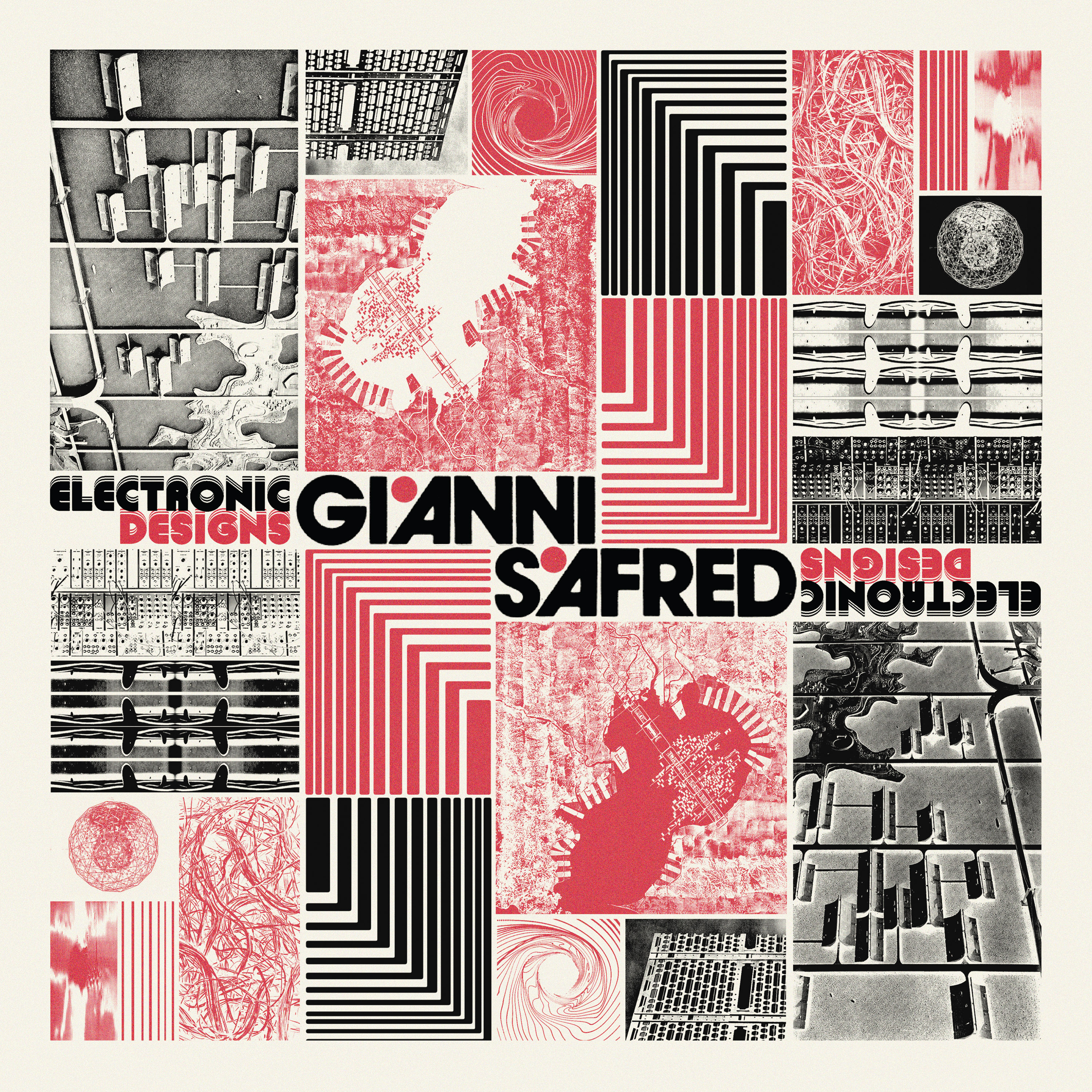
LP Vinyl Black
Out on April 28th, 2022
TRACKLIST:
A1 – Automatic Age
A2 – Mystification
A3 – City Problems
A4 – Spheres
A5 – Trapdoor
A6 – Hastly Chant
B1 – Elastic Points
B2 – Sacred Interlude
B3 – Jazz Motion Study
B4 – Planetarium
B5 – Bottom Up
B6 – Poe’s Clock
Entirely remastered from the original analogue tapes and featuring brand new artwork designed by Luke Insect, this Four Flies reissue finally brings back to life one of the most surprising albums from the strange phenomenon that was the Italian library music of the Seventies.
Gianni Safred’s Electronic Designs was released in 1977 on the Milanese label Jump, in their “Music Scene” series, simply as a collection of musical pieces intended for use in television programmes. However, hidden behind a nondescript cover were twelve electronic music tracks revealing a recognizable style of composition; twelve little gems masterly combining experimentation, catchiness and practical functionality thanks to a unified and unique style. Each through a specific mood, these tracks give expression to Safred’s distinctive sound, where irresistible mechanical grooves are over-layered with melodic lines perfectly played on a Polymoog or ARP Odyssey.
A native of Trieste, Safred started out with little swing bands soon after WW2, before eventually playing with great soloists like Django Rheinhardt. Ultimately, it is his background as a jazz pianist that makes Electronic Designs so special. As with other Italian jazzmen who got into synthesizers (above all, Piero Umiliani), Safred’s blend of complex harmonies and (quasi-) bebop virtuoso flourishes, with its obsessive repetitions and refined tone colours, gives a retro-futuristic quality to this library album, whose electronic music islight-years ahead ofthe ‘pop’ electronic music of the time and, in many ways, anticipates the best stylistic features of early-Nineties dance music.
Safred best expresses his experimental verve – and does a great job in creating the ‘electronic designs’ of the title – in “Mystification”, “City Problems”, “Trapdoor”, “Planetarium” and “Poe’s Clock”, all of which unfold through hypnotic beats and sinusoid or square wave explosions. In other tracks, however, the compositional style is less unconventional, with relaxed yet not banal atmospheres (“Spheres”, “Elastic Points”, “Sacred Interlude”), as well as flashes of irresistible groove inspired by Herbie Hancock’s more pop-oriented work (“Automation Age”, “Jazz Motion Study”, “Bottom Up”). The album’s masterpiece is arguably “Hasty Chant”, a detective-funk ride with an unforgettable theme, which manages to pull all of the album’s various strands into a cohesive whole – as a side note, the allusive and apt description of the song on the back cover reads: “Things are happening“.